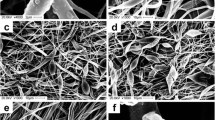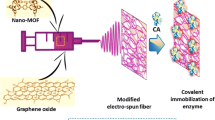Abstract
Electrospinning was applied to create easy-to-handle and high-surface-area membranes from continuous nanofibers of polyvinyl alcohol (PVA) or polylactic acid (PLA). Lipase PS from Burkholderia cepacia and Lipase B from Candida antarctica (CaLB) could be immobilized effectively by adsorption onto the fibrous material as well as by entrapment within the electrospun nanofibers. The biocatalytic performance of the resulting membrane biocatalysts was evaluated in the kinetic resolution of racemic 1-phenylethanol (rac-1) and 1-phenylethyl acetate (rac-2). Fine dispersion of the enzymes in the polymer matrix and large surface area of the nanofibers resulted in an enormous increase in the activity of the membrane biocatalyst compared to the non-immobilized crude powder forms of the lipases. PLA as fiber-forming polymer for lipase immobilization performed better than PVA in all aspects. Recycling studies with the various forms of electrospun membrane biocatalysts in ten cycles of the acylation and hydrolysis reactions indicated excellent stability of this forms of immobilized lipases. PLA-entrapped lipases could preserve lipase activity and enantiomer selectivity much better than the PVA-entrapped forms. The electrospun membrane forms of CaLB showed high mechanical stability in the repeated acylations and hydrolyses than commercial forms of CaLB immobilized on polyacrylamide beads (Novozyme 435 and IMMCALB-T2-150).






Similar content being viewed by others
References
Zarie ES, Kaidas V, Gedamu D, Mishra YK, Adelung R, Furkert FH, Scherließ R, Steckel H, Groessner-Schreiber B (2012) Solvent free fabrication of micro and nanostructured drug coatings by thermal evaporation for controlled release and increased effects. PLoS One. doi:10.1371/journal.pone.0040746
Breuer M, Ditrich K, Habicher T, Hauer B, Kesseler M, Stürmer R, Zelinski T (2004) Industrial methods for the production of optically active intermediates. Angew Chem Int Ed 43:788–824. doi:10.1002/anie.200300599
Dlugy C, Wolfson A (2007) Lipase catalyse glycerolysis for kinetic resolution of racemates. Bioprocess Biosyst Eng 30:327–330. doi:10.1007/s00449-007-0128-x
Ghanem A, Aboul-Enein HY (2004) Lipase-mediated chiral resolution of racemates in organic solvents. Tetrahedron Asymmetr 15:3331–3351. doi: 10.1016/j.tetasy.2004.09.019
Kapoor M, Gupta MN (2012) Lipase promiscuity and its biochemical applications. Process Biochem 47:555–569. doi:10.1016/j.procbio.2012.01.011
Liese A, Seelbach K, Wandrey C (2006) Industrial biotransformations. WILEY-VCH Verlag GmbH & Co. KGaA, Weinheim
Sheldon RA (2007) Enzyme Immobilization: the quest for optimum performance. Adv Synth Catal 349:1289–1307. doi:10.1002/adsc.200700082
Rodrigues RC, Ortiz C, Berenguer-Murcia Á, Torres R, Fernández-Lafuente R (2013) Modifying enzyme activity and selectivity by immobilization. Chem Soc Rev 42:6290–6307. doi:10.1039/c2cs35231a
Brady D, Jordaan J (2009) Advances in enzyme immobilisation. Biotechnol Lett 31:1639–1650. doi:10.1007/s10529-009-0076-4
Dyal A, Loos K, Noto M, Chang SW, Spagnoli C, Shafi KVPM, Ulman A, Cowman M, Gross RA (2003) Activity of Candida rugosa lipase immobilized on gamma-Fe2O3 magnetic nanoparticles. J Am Chem Soc 125:1684–1685. doi:10.1021/ja021223n
Garcia-Galan C, Berenguer-Murcia Á, Fernandez-Lafuente R, Rodrigues RC (2011) Potential of different enzyme immobilization strategies to improve enzyme performance. Adv Synth Catal 353:2885–2904. doi:10.1002/adsc.201100534
Mateo C, Palomo JM, Fernandez-Lorente G, Guisan JM, Fernandez-Lafuente R (2007) Improvement of enzyme activity, stability and selectivity via immobilization techniques. Enzyme Microb Technol 40:1451–1463. doi:10.1016/j.enzmictec.2007.01.018
Lei J, Fan J, Yu C, Zhang L, Jiang S, Tu B, Zhao D (2004) Immobilization of enzymes in mesoporous materials: controlling the entrance to nanospace. Microporous Mesoporous Mater 73:121–128. doi:10.1016/j.micromeso.2004.05.004
Avnir D, Coradin T, Lev O, Livage J (2006) Recent bio-applications of sol–gel materials. J Mater Chem 16:1013–1030. doi:10.1039/b512706h
Weiser D, Boros Z, Hornyánszky G, Tóth A, Poppe L (2012) Disubstituted dialkoxysilane precursors in binary and ternary sol–gel systems for lipase immobilization. Process Biochem 47:428–434. doi:10.1016/j.procbio.2011.11.023
Lalonde J, Margolin A (2008) Immobilization of enzymes. In: Drauz K, Waldmann H (eds) Enzym. catal. org. synth. Wiley-VCH Verlag GmbH, Weinheim, pp 163–184
Lee S-M, Jin LH, Kim JH, Han SO, Bin NaH, Hyeon T, Koo Y-M, Kim J, Lee J-H (2010) Beta-glucosidase coating on polymer nanofibers for improved cellulosic ethanol production. Bioprocess Biosyst Eng 33:141–147. doi:10.1007/s00449-009-0386-x
Ansari SA, Husain Q (2012) Potential applications of enzymes immobilized on/in nano materials: a review. Biotechnol Adv 30:512–523. doi:10.1016/j.biotechadv.2011.09.005
Wu L, Yuan X, Sheng J (2005) Immobilization of cellulase in nanofibrous PVA membranes by electrospinning. J Membr Sci 250:167–173. doi:10.1016/j.memsci.2004.10.024
Sóti PL, Telkes L, Rapi Z, Tóth A, Vigh T, Nagy ZK, Bakó P, Marosi G (2014) Synthesis of an aza chiral crown ether grafted to nanofibrous silica support and application in asymmetric Michael addition. J Inorg Organomet Polym Mater 24:713–721. doi:10.1007/s10904-014-0037-9
Sakai S, Liu Y, Yamaguchi T, Watanabe R, Kawabe M, Kawakami K (2010) Production of butyl-biodiesel using lipase physically-adsorbed onto electrospun polyacrylonitrile fibers. Bioresour Technol 101:7344–7349. doi:10.1016/j.biortech.2010.04.036
Huang X-J, Chen P-C, Huang F, Ou Y, Chen M-R, Xu Z-K (2011) Immobilization of Candida rugosa lipase on electrospun cellulose nanofiber membrane. J Mol Catal B Enzym 70:95–100. doi:10.1016/j.molcatb.2011.02.010
Nakane K, Ogihara T, Ogata N, Yamaguchi S (2005) Formation of lipase-immobilized poly(vinyl alcohol) nanofiber and its application to flavor ester synthesis. Sen’i Gakkaishi 61:313–316. doi:10.2115/fiber.61.313
Sakai S, Antoku K, Yamaguchi T, Kawakami K (2008) Development of electrospun poly(vinyl alcohol) fibers immobilizing lipase highly activated by alkyl-silicate for flow-through reactors. J Membr Sci 325:454–459. doi:10.1016/j.memsci.2008.08.008
Zhou Y, Lim L-T (2009) Activation of lactoperoxidase system in milk by glucose oxidase immobilized in electrospun polylactide microfibers. J Food Sci 74:170–176. doi:10.1111/j.1750-3841.2009.01071.x
Sóti PL, Nagy ZK, Serneels G, Vajna B, Farkas A, Van der Gucht F, Fekete P, Vigh T, Wagner I, Balogh A, Pataki H, Mező G, Marosi G (2015) Preparation and comparison of spray dried and electrospun bioresorbable drug delivery systems. Eur Polym J 68:671–679. doi:10.1016/j.eurpolymj.2015.03.035
Chen CS, Fujimoto Y, Girdaukas G, Sih CJ (1982) Quantitative analyses of biochemical kinetic resolutions of enantiomers. J Am Chem Soc 104:7294–7299. doi:10.1021/ja00389a064
Tomin A, Hornyánszky G, Kupai K, Dorkó Z, Ürge L, Darvas F, Poppe L (2010) Lipase-catalyzed kinetic resolution of 2-methylene-substituted cycloalkanols in batch and continuous-flow modes. Process Biochem 45:859–865. doi:10.1016/j.procbio.2010.02.006
Tomin A, Weiser D, Hellner G, Bata Z, Corici L, Péter F, Koczka B, Poppe L (2011) Fine-tuning the second generation sol–gel lipase immobilization with ternary alkoxysilane precursor systems. Process Biochem 46:52–58. doi:10.1016/j.procbio.2010.07.021
Kister G, Cassanas G, Vert M (1998) Effects of morphology, conformation and configuration on the IR and Raman spectra of various poly(lactic acid)s. Polymer 39:267–273. doi:10.1016/S0032-3861(97)00229-2
Kurbanoglu EB, Zilbeyaz K, Kurbanoglu NI, Ozdal M, Taskin M, Algur OF (2010) Continuous production of (S)-1-phenylethanol by immobilized cells of Rhodotorula glutinis with a specially designed process. Tetrahedron Asymmetr 21:461–464. doi:10.1016/j.tetasy.2010.01.019
Queiroz N, Nascimento MG (2002) Pseudomonas sp. lipase immobilized in polymers versus the use of free enzyme in the resolution of (R, S)-methyl mandelate. Tetrahedron Lett 43:5225–5227. doi:10.1016/S0040-4039(02)01057-2
Högberg H-E (2008) Exploiting enantioselectivity of hydrolases in organic solvents organic. Synthesis with enzymes in non-aqueous media. Wiley-VCH Verlag GmbH & Co. KGaA, Weinheim
Acknowledgments
The research was supported by the OTKA Research Fund (code 112644 and code 108975). Besides this project is supported by the New Széchenyi Plan (Project ID: TÁMOP-4.2.1/B-09/1/KMR-2010-0002), János Bolyai Research Scholarship of the Hungarian Academy of Sciences and MedInProt Project. The authors would like to express their special thanks to NanGenex Inc., (Budapest, Hungary) for DLS measurements.
Author information
Authors and Affiliations
Corresponding author
Additional information
L. Poppe and G. Marosi have contributed equally to this work.
Rights and permissions
About this article
Cite this article
Sóti, P.L., Weiser, D., Vigh, T. et al. Electrospun polylactic acid and polyvinyl alcohol fibers as efficient and stable nanomaterials for immobilization of lipases. Bioprocess Biosyst Eng 39, 449–459 (2016). https://doi.org/10.1007/s00449-015-1528-y
Received:
Accepted:
Published:
Issue Date:
DOI: https://doi.org/10.1007/s00449-015-1528-y




